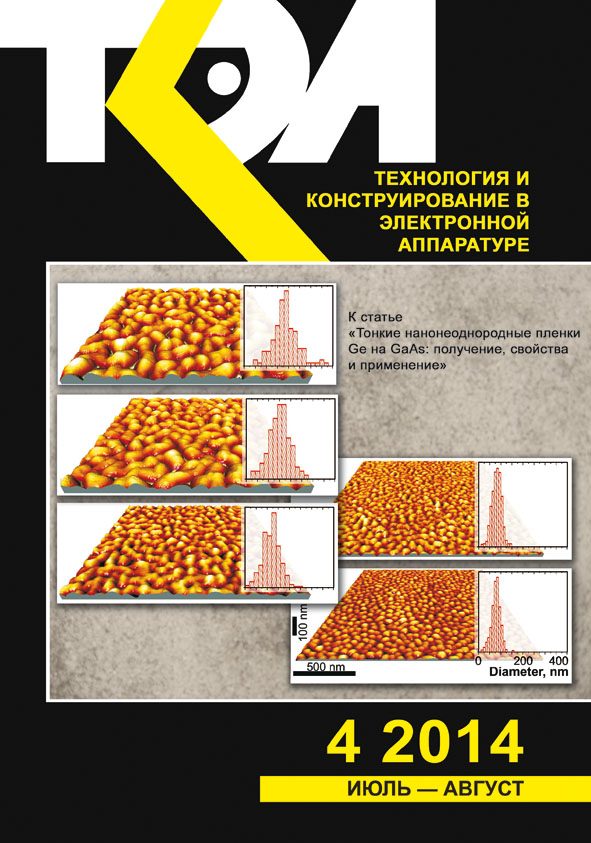Features of transformation of impurity-defect complexes in СdTe:Сl under the influence of microwave radiation
Abstract
High-resistance cadmium telluride single crystals are promising material for production of ionizing radiation detectors. To increase crystal resistance, they are doped with chlorine. The detector quality depends on uniformity of chlorine impurity distribution over the crystal.
It is known that low-dose microwave irradiation can homogenize impurity distribution in a specimen. In the present work, we made an attempt to improve the detector material quality by using such post-technological treatment, as well as to study state variation for impurity-defect complexes. To this end, the effect of microwave irradiation on transformation of impurity-defect complexes in CdTe:Cl single crystals was investigated using low-temperature photoluminescence. It is shown that activation of ClTe donor centers by microwave irradiation for 10 s and presence of VCd acceptor centers in the specimens under investigation effectively facilitate formation of (VNd–ClTe) defect centers at which excitons are bound.
Detailed investigations of the band form for donor-acceptor pairs (DAPs) in CdTe:Cl single crystals made it possible to determine the Huang — Rhys factor (that characterizes electron-phonon interaction in CdTe:Cl DAPs) as a function of microwave treatment duration. It is shown for single crystals with NCl = 5·1017 cm–3 and 5·1019 cm–3 that the Huang — Rhys factor grows with microwave irradiation dose. This is related to both homogenization of donor and acceptor centres distribution and increase of donor—acceptor spacing. It is shown that microwave irradiation of CdTe:Cl single crystals results in concentration reduction for separate cadmium vacancies VCd because of formation of (VNd–ClTe) defect centres at which excitons are bound.
References
Korbutyak D. V., Mel'nichuk S. V., Korbut Ye. V., Borisyuk M.M. [Cadmium Telluride: impurity-defect states and detector properties]. Kiev, Ivan Fedorov, 2000, 198 p.
Kul'chitskii N. A., Naumov A. V. Tsvetnaya metallurgiya, 2010, no 2, pp. 31-44. (Rus)
Del Sordo S., Abbene L., Caroli E. et al. (Review) Progress in the development of CdTe and CdZnTe semiconductor radiation detectors for astrophysical and medical applications. Sensors, 2009, vol. 9, pp. 3491-3526. http://dx.doi.org/10.3390/s90503491
Rzhanov A. V., Gerasimenko N. N., Vasil'ev S. V., Obodnikov V. I. Pis'ma v ZhTF, 1981, vol. 7, iss. 20, pp. 1221-1223. (Rus)
Vinnik E. V., Guroshev V. I., Prokhorovich A. V., Shevel'ev M. V. Optoelektronika i poluprovodnikovaya tekhnika, 1989, iss. 15, pp. 48-50. (Rus)
Kryshtab T. G., Semenova G. N., Litvin P. M. et al. Optoelektronika i poluprovodnikovaya tekhnika, 1996, iss. 31, pp. 140-145. (Rus)
Lee Y.-J., Cho T.-Ch., Chuang Sh.-Sh. et al. Low-temperature microwave annealing processes for future IC fabrication – a review. IEEE Transactions on electron devices, 2014, vol. 61, no 3, pp. 651-665.
Atanassova E. D., Belyaev A. E., Konakova R. V. et al. Effect of active actions on the properties of semiconductor materials and structures. Kharkiv, NTC “Institute for Single Crystals”, 2007, 216 р.
Soltani M., Certier M., Evrard R., Kartheuser E. Photoluminescence of CdTe doped with arsenic and antimony acceptors. J. Appl. Phys, 1995, vol. 78, no 9, pp. 5626-5632.
Korbutyak D. V., Lotsko A. P., Vakhnyak N. D. et al. Effect of microwave irradiation on the photoluminescence of bound excitons in CdTe:Cl single crystals. Semiconductors, 2011, vol. 49, iss. 9, pp. 1133-1139. http://dx.doi.org/10.1134/S1063782611090119
Copyright (c) 2014 Budzulyak S. I., Korbutyak D. V., Lots'ko A. P., Vakhnyak N. D., Kalitchuk S. M., Demchina L. A., Konakova R. V., Shinkarenko V. V., Mel'nichuk A. V.

This work is licensed under a Creative Commons Attribution 4.0 International License.

